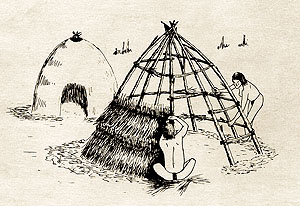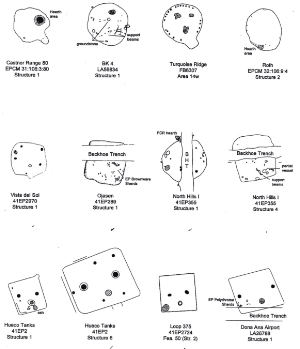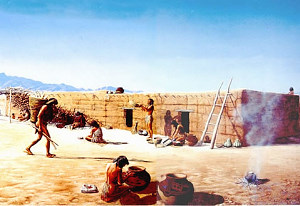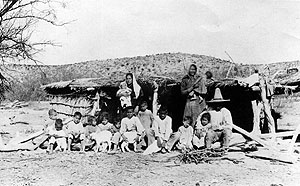Huts to Pueblos
Between 4500 and 500 years ago, the western Trans-Pecos witnessed a transformation in architectural form from huts to pueblos. Informal circular structures gave way to more substantial square ones that were eventually joined together to create multi-room pueblos. These shifts in architecture accompanied a steady decrease in mobility and the development of semi-permanent village settlements, all possible because agriculture supplied an increasingly large part of the diet. Though these changes did not go unnoticed in the eastern Trans-Pecos, only the La Junta district experienced any similar architectural developments.
Huts
The earliest archeological evidence of huts (wickiups) in the Trans-Pecos occurs around 2700 B.C. in the Rio Grande Valley near present-day El Paso and on the mesas to the east and west of the valley. There is little reason to suspect that earlier peoples did not also construct simple hut-like dwellings, but evidence of such structures has not been found by archeologists. Huts were small, circular structures built in shallow pits 15 to 20 centimeters (6 to 8 inches) deep. They had frameworks made of branches that were thatched with grass, and simple dirt floors that contained small hearths.
The huts at Keystone Dam were the largest and most intensively used of these early house structures. They measured 3 meters (10 feet) in diameter and their grass thatch was covered with an insulating layer of burned mud plaster. Such huts were likely occupied by mobile hunter-gatherers during the cooler months and used as storage facilities for plant foods gathered throughout the rest of the year. Though the archeological evidence for huts is meager between 1800 B.C. and A.D. 200, it appears that they continued to be constructed throughout the rest of the Archaic period.
Pithouses
The early part of the Formative period in the western Trans-Pecos, known as the Mesilla phase (A.D. 200-1000), is characterized by the appearance of circular and square pithouses. Circular pithouses were more prevalent than square ones throughout the Mesilla phase, but towards its end this trend began to reverse. Huts continued to be built throughout the Mesilla phase, but they became less common after A.D. 700.
Pithouses were slightly larger, deeper, and more substantial than huts, but were still informal in their construction. They had dirt floors and some contained small hearths and storage pits, but many lacked any floor features. Like huts, pithouses were probably used as winter shelters and food storage rooms. The exception to this pattern comes from the pithouses at Turquoise Ridge, which were the largest and most extensively used and maintained pithouses known in the western Trans-Pecos. Their floors contained hearths and a large number and variety of pits and basins. The structures were likely occupied for longer durations than other pithouses in the region.
Pitrooms
The Doña Ana phase (A.D. 1000-1275) is a period of transition between the informal architecture and mobile settlement system of the Mesilla phase and the puebloan settlements of the El Paso phase. Square pithouses were constructed consistently throughout the Doña Ana phase, but huts and circular pithouses all but disappeared after A.D. 1000. Ojasen and Gobernadora provide examples of typical square pithouse villages for this period.
An important aspect of the Doña Ana phase is the appearance of pitrooms. Pitrooms were much more formal and uniform than pithouses, with adobe walls and floors that were sometimes plastered with caliche. The floors contained formal hearths and storage pits, and sometimes had stepped entryways. Pitrooms dramatically increased in number during the late Doña Ana phase (A.D. 1150-1275).
The increasing formality in architectural form that took place during the Doña Ana phase was accompanied by a pattern of decreased mobility and an increased reliance on agriculture. Cross-cultural studies of architectural form link round, insubstantial structures with mobile settlement patterns and angular, formal structures with sedentism. The shift from circular huts and pithouses to square pithouses and pitrooms during the Doña Ana phase reflects a decrease in mobility that coincides with an increased reliance on both agriculture and storage. This shift becomes very noticeable during the late Doña Ana phase. At some sites from this period pitrooms were joined together to create mini pueblos. Hueco Tanks, for example, contains a two-room pueblo among several isolated pitrooms. These mini pueblos were the forerunners of the large pueblos characteristic of the subsequent El Paso phase.
Pueblos
After A.D. 1275, square pithouses experienced a sharp decline in number and pitrooms and small pueblos began to give way to large pueblos containing one or more contiguous blocks of rooms. Each of these room blocks contained about ten rooms, one of which was typically larger than the others and is thought to have served communal and ceremonial functions. Pueblo rooms had adobe walls and floors that were plastered with caliche. They contained formal hearths, storage pits, stepped entryways, and sometimes raised "altars." Despite the predominance of pueblos, pitrooms continued to be built throughout the El Paso phase. Firecracker Pueblo provides a very late example of a pitroom village that was rapidly replaced with a pueblo, likely by the same villagers.
The appearance of pueblos during the El Paso phase coincides with the emergence of a specialized agricultural economy. During this time, the people of the western Trans-Pecos relied heavily on crops such as corn, beans, and squash and built pueblos close to their fields. They did not reside year-round in pueblos, however. Instead, they appear to have dispersed to isolated pitrooms during part of the year, but the function of these pitrooms is not clear.
Around A.D. 1450 the pueblos of the western Trans-Pecos were abandoned and the region was largely depopulated. Though it is unclear exactly why this occurred, it has been hypothesized that the agricultural economy of the western Trans-Pecos had become too specialized and was crippled by an extended period of drought, leading to wide-spread subsistence failure. The people who remained in the region between A.D. 1450 and 1680 reverted to a less intensive mobile adaptation that had closer affinities with the adaptations of the Middle Archaic period than with those of the Late Archaic and Formative periods. When Spanish explorers arrived in the western Trans-Pecos in the late 16th century, they found people living in huts who did not practice agriculture. Dona Ana County Airport is the only known archeological site in the region that dates to this time period.
Eastern Trans-Pecos
Although obviously aware of the changes taking place in the western Trans-Pecos, the people of the eastern Trans-Pecos maintained the lifestyle that they had established during the Late Archaic period. They lived in huts, moved their camps frequently, and continued to live off the land. The huts of the eastern Trans-Pecos were very similar to those of the western Trans-Pecos, except that they were not built over pits, so they required rocks to be placed around their outer edges to bolster their wooden frameworks. Rings of these rocks (called wickiup rings) are common at Late Prehistoric sites in the eastern Trans-Pecos, such as Squawteat Peak, and in Cielo complex sites in the Big Bend.
La Junta Villages
The exception in this pattern in the eastern Trans-Pecos is in the La Junta district, where pithouse villages developed around A.D. 1200. These small pithouses were more substantial than the pithouses of the western Trans-Pecos and probably more comparable to pitrooms. Called jacales, they were built in pits 1 to 2 meters (3 to 6 feet) deep and had wattle and daub walls and roofs as well as well-made adobe floors with "altars." Most of them were circular or rectangular and stood apart from one another, but one multi-room pueblo has been identified at the Millington site. The circular jacales are significantly smaller than the rectangular ones and some apparently represent storage facilities, rather than habitation structures. La Junta villagers practiced agriculture, but continued to rely heavily on wild plants and animals. They never became as agriculturally specialized or as sedentary as the people of the western Trans-Pecos.
Unlike the pueblos of the western Trans-Pecos, the villages of La Junta were not abandoned after A.D. 1450. In fact, the people of La Junta were the first that Cabeza de Vaca encountered on his eight year journey from Galveston Island to Mexico City who lived in settled villages and practiced agriculture (see Learning from Cabeza de Vaca). During the subsequent centuries of Spanish, Mexican, and American rule, construction materials and techniques changed very little and well into the 20th century, the people of La Junta (vicinity of present-day Presidio, Texas and Ojinaga, Mexico) continued to build their houses in essentially the same way as their ancestors had, some 700 years earlier.
Contributed by Carly Whelan.
Sources
Kelley, J. Charles
1985 Review of the Architectural Sequence at La Junta de los Rios. In Proceedings of the Third Jornada Mogollon Conference, edited by M. S. Foster and T. C. O’Laughlin. The Artifact 23(1 & 2):149–159. ![]()
Miller, Myles R. and Nancy A. Kenmotsu
2004 Prehistory of the Jornada Mogollon and Eastern Trans-Pecos Regions of West Texas. In: The Prehistory of Texas, edited by Timothy K. Perttula, pp. 205-265. Texas A&M University Press, College Station.![]()
O’Laughlin, Thomas C.
1980 The Keystone Dam Site and Other Archaic and Formative Sites in Northwest El Paso, Texas. El Paso Centennial Museum Publications in Anthropology No. 8. The University of Texas at El Paso.
Whalen, Michael
1994a Moving out of the Archaic on the Edge of the Southwest. American Antiquity 59(4):622-638.
1994b Turquoise Ridge and Late Prehistoric Mobility in the Desert Mogollon Region. Anthropological Paper No. 118. University of Utah Press, Salt Lake City.
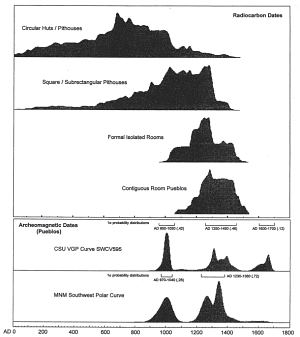
|
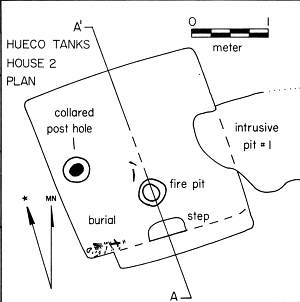
|
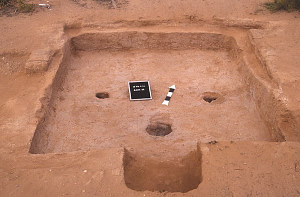
|
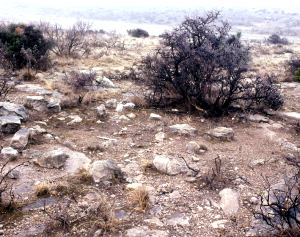
|
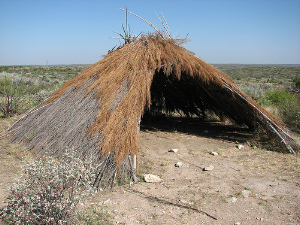
|
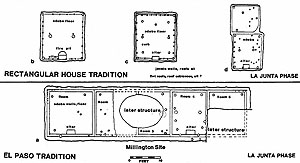
|
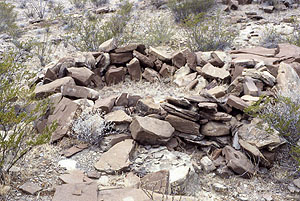
|
